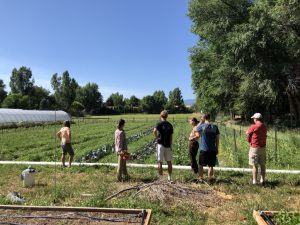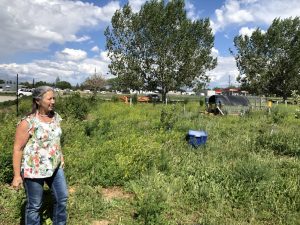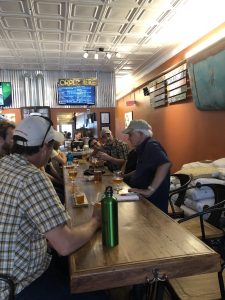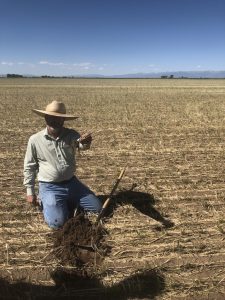After visiting the Colorado Springs Food Rescue and speaking to Zac Chapman and Shane Lory on Tuesday of last week, we moved on from studying food security, justice, access, and sovereignty to studying the influence of politics on the agricultural sector and the experience of farming in America (or at least in Colorado). This transition was fitting because we students were working on writing a comment letter, addressed to the USDA and Sonny Perdue, regarding a proposed Animal and Plant Health Inspection Services (APHIS) rule that would expedite the deregulation of genetically engineered (GE) organisms and decrease oversight over developers of those engineered species. This 100+ page proposed rule highlights just how consequential specific alterations of processes of government oversight and involvement can be. Sonny Perdue and the Trump administration are dead-set on deregulated big agriculture and shrinking government oversight of agricultural markets. Perdue, a climate denier, has made no attempt to incentivize the adoption of sustainable agriculture techniques by farmers, nor to develop a market for those goods. Instead, the USDA is moving headquarters from DC to Kansas City, a move that is creating upheaval in the department and is resulting in the resignation of many career scientists and policy makers. Beyond that, it looks like Trump’s farm bailouts–which were needed to prop up US agriculture in the ongoing trade war with China–were distributed to a select few farmers in specific locations. I am not sure if this blunder has been exposed as blatant corruption, but multiple checks were sent under different names to the same addresses. In any case, if one takes the time to parse out the consequences of this proposed APHIS bill, it is clear that it would allow developers to flood the market with GE organisms that are not at all safe; it would benefit a few mega corporations at the expense of the environment, the economy, and consumers at large (the public); it would be a major national security threat; it would worsen all of the problems effecting rural America and America’s farmland; and it would fail to protect non-consenting farmers and the public from contamination of their land and their food supply by GE organisms and the chemicals associated with them. The language in the bill suggests that APHIS is transitioning to becoming a market facilitating agency rather than a regulatory agency. The bill would axe APHIS’s regulatory capacity and replace it with a model neoliberal institution made to help big ag right along. This interpretation is all my own, but it does correspond to the reality of the farmers the class met with this past week.
Steve Ela operates a tree fruit farm on the Western Slope, Ela Family Farms, that has been in his family for four generations. We spoke to him about his farming strategies, his growing season, his issues with water and frost and labor, and his products and markets. Steve’s operation is very impressive and his answers to all of these questions were eye-opening. It takes a whole lot of smarts, planning, luck, and a good team to make a living off of growing organic fruit. If subsidies and incentives were rearranged, these obstacles would be decreased in intensity some, but as it stands, farming with an objective of growing the tastiest, freshest, and healthiest product in a way that benefits the land and local community is significantly harder than growing commodity crops using chemical inputs in dirt, and relying on crop insurance. For some of these reasons, Steve serves on the National Organic Standards Board, on top of managing his farm’s operations. The class spoke to him about how the Organic Standards Board operates and what it can and cannot do. The organization is a tiny part of the USDA, but it has oversight over organic certification standards. There is a bit of a crisis going on in the organics world right now because a recent vote ruled in favor for the classification of hydroponic agriculture as a certified organic method. This removes soil from the definition of organic, which is a major problem if soil health and conservation is to remain a goal of ‘good’ farming practices. Therefore, some farmers and distributors are abandoning the organic label in favor of labels like Certified Naturally Grown and Regenerative Organic. Steve opposed the organic soilless medium vote, but his work continues at the Board. The organics market is growing, despite all of the barriers to entry for farmers. Steve wants to make sure that going organic can become a more attractive option for farmers and he wants to make sure that the integrity of the certification is maintained.

After Steve Skyped out, Randy Kruse from Bon Appétit at Colorado College came in to talk to us about what Bon Appétit is doing to support local agriculture and to answer any other questions we had. Many Colorado College students are outraged by Bon Appétit for just about any reason they can come up with. These are mostly unfounded, as it turns out. And in fact, the reason Bon Appétit serves so much pizza, bacon, and chicken, is because that is what CC students truly want to eat, despite their grumbling about Bon Appétit’s unsustainable culpability. It also turns out that CC students steal an absurd amount of the plates, cups, and cutlery at Rastall, so Bon Appétit cannot afford to replace their single-use serving containers with reusable ones. CC also has recycling bin contamination rates above the national average, which is crazy considering that every bin has an illustrated sign with directions of what exactly to place where. We also all grew up very much educated (I am pretty sure I can say) about how to dispose of what properly. Also, CC students really want the packaged goods sold at the C store, Mandy B’s, CC Coffee, and the Preserve. That requires a lot of extra work for CC’s Bon Appétit administration because the company is really focused on preparing things from scratch, not sourcing processed goods. CC is quite unique in this demand, compared to the other schools and institutions Bon Appétit services. To be fair, the closest grocery store is a 30min walk from campus and CC does not exactly encourage students to leave campus, cook for themselves, or generally be self-sufficient. So it makes sense that CC students want their chips and kombucha sold on campus. But that is why those things are so overpriced. CC students’ food tastes, demand and frankly their irresponsible behavior is what is driving most of Bon Appétit’s sustainability troubles. And, with the Block Plan, hiring people to work the cafes and food service is super tough. They only work around seven months a year, and although Bon Appétit pays a $15-$16/hour, they are hard-pressed to find employees. Also, the hours are strange and the work is hard because most of campus eats at the same exact time, across multiple locations and the school has certain expectations of the food service in order to attract new students and to foster their idea of a ‘campus community’. The other issue is that Colorado Springs sits outside of the distribution networks for most Colorado-grown produce and meat. Getting contracts with local producers requires a whole lot of logistics and independent trucks and so forth. In conclusion, it appears Bon Appétit is doing just about the best they can and students should really stop it with the grumbling.

On Friday the fifth, the class to a trip to Cañon City to visit Susan Gordon and Sarah Hamilton at New Roots Farm. Susan and her husband directed Venetucci Farms just south of Colorado Springs for a number of years. It was shut down about two years ago because the water supply was found to be exceedingly contaminated with PFAS toxic chemicals used by the Air Force. This farm had had a strong CSA membership and families visited often, especially for the pumpkin harvest. Once it was shutdown, the family moved back to Cañon City where just a year and a half ago, Susan’s daughter Sarah started the market garden and farm, New Roots, on their property. With the help of her community and family, Sarah built up New Roots without any outside labor or contracting, a truly impressive feat. She now grows a wide variety of produce for the farmers market and her CSA. She has cultivated a habitat for pollinators and birds with a whole bunch of pretty flowers and intercropping. She has lettuces, peas, squash, garlic, tomatoes, brassicas, herbs, peppers, and more. She also has a pasture of goats who are quite funny, a mobile chicken coop, and some cats. Sarah is committed to cultivating healthy soil, efficiently irrigating her crops in what is a very arid environment, and cultivating a diverse ecosystem (beyond growing super healthy food for Southern Colorado residents). After talking with Susan and Sarah, touring the farm, and weeding a few rows of popcorn, the class was treated to a farm-fresh lunch prepared by Prof Harris’ wife who accompanied us down to Cañon City. A very pleasant visit.

On Monday of this week, the class hopped in a big, white CC van and headed to the San Luis Valley. After dropping our stuff at Baca Campus in Crestone, we drove down to Alamosa and met with Cleave Simpson, General Manager of the Rio Grande Water Conservation District. The San Luis Valley has a historic agricultural economy, but the Rio Grande’s water rights have been over-appropriated for at least 100 years. Colorado has a compact with New Mexico, Texas, and Mexico, so they have to leave some water for the municipalities, farmers, and ecosystems further south. The Valley’s aquifer is dangerously close to being empty. What is more, the Valley has been experiencing a prolonged drought, otherwise known as aridification and desertification, for twenty years. This year has been exceptionally wet, which is good, but it is not in keeping with the historical pattern of rising temperatures, decreasing snow pack and precipitation. For all of these reasons, farmers are really struggling and so Cleave is working on reforming water management across the Valley in order to replenish the aquifer at least to a stable level, and to maintain the agricultural community that will otherwise be forced to quit or move. Farmers need to be more efficient with their irrigation, they need to build up the water retention capacity of the soil, and they need to switch to crops that are less water-dependent. But getting those farmers to change is no easy task.

After meeting with Cleave, we drove over to downtown Alamosa to see Liza Marron, Executive Director of the San Luis Valley Local Foods Coalition. The Coalition engages in multiple projects to support local food production and the local community. They distribute food grown at local farms with healthy and sustainable practices to consumers and retailers across a 250 mile range. They support local, responsible producers and they make eating healthy and local food a possibility for the low-income members of the San Luis Valley community. They also empower these folks, largely immigrants and refugees, with their projects and programs utilizing their commercial kitchen and education gardens and such. The Coalition has a successful farm-to-school program, they are involved in policy and advocacy work, and they are building up a 30-some acre farm park on a sight that was once a school. It is just off the Rio Grande and it is called the Rio Grande Farm park. They have, I believe, eight plots that are already being cultivated by experienced Latin American farmers who otherwise would not be able to afford land. They also have volunteers and interns. The project is just breaking ground, and so beyond the very productive farm and a very biodiverse orchard and a mobile chicken coop, they are developing an educational garden, a compost park, community center, and so forth. As we toured the Farm Park with Liza, we ran in to the author, academic, and policy advisor Mark Winne who was also touring the farm park and seeing what the SL Valley Local Foods Coalition was up-to. He is the senior advisor to the Center for a Livable Future at Johns Hopkins Bloomberg School of Public Health and founded the Community Food Security Coalition. He is quite well known in the food policy space. We had an interesting conversation with him out in the garden, he gave us all his business card, and then we went over to a brewery in town whose malt is made with local barley, where he bought us a round of drinks. There, we had a good time talking to some of the other individuals who are involved in the Alamosa/San Luis Valley local food movement and talked about how the Valley can change and evolve to attract business, entrepreneurs, and grow the local food movement.


The last stop on our trip in the San Luis Valley was on Tuesday afternoon. We drove over from Crestone (where we were staying) west to Mosca to visit the agronomist Patrick O’Neill at Nissen Farms. He has been advising the farmers there since 2005 in response to the farmers’ desire to reduce inputs including water, to improve soil health, and to produce a better crop on smaller acreage. He has done just that, despite the ongoing aridification of the Valley. Nissen Farms has a rotation of the cash crops potatoes and barley (standard in the Valley), and they now cover their non-cash crop acres with grasses that improve soil health and make the soil ‘spongier’, decrease the potato nematode pest prevalence, and feed the herd of cows that the farmers pasture. O’Neill is a soil health consultant working in the Valley. He also volunteers for soil conservation projects. He has strong and very accurate opinions about how farming should be done around there, what sorts of policies could help improve America’s farm land and rural communities, and how chemical companies and retailers should remodel to decrease waste and improve the food system. But really, O’Neill is a scientist and he quizzed us on our knowledge about how soil works (we maybe got a C- on that quiz). The story of farming in America is not a very uplifting one, especially considering the increasingly dismal health outcomes, the rising suicide rate, and the opium addiction crises there. O’Neill feels like rural America has no say in public life and does not have many advocates in Washington. He believes that unless the cosmopolitan elite addresses the reality of rural populations, the food system will never improve and our healthcare crises and the country’s political polarization will spiral out of control. For Patrick, it all hinges on the soil which really is the basis of our civilization, culture, economy, and nation.
